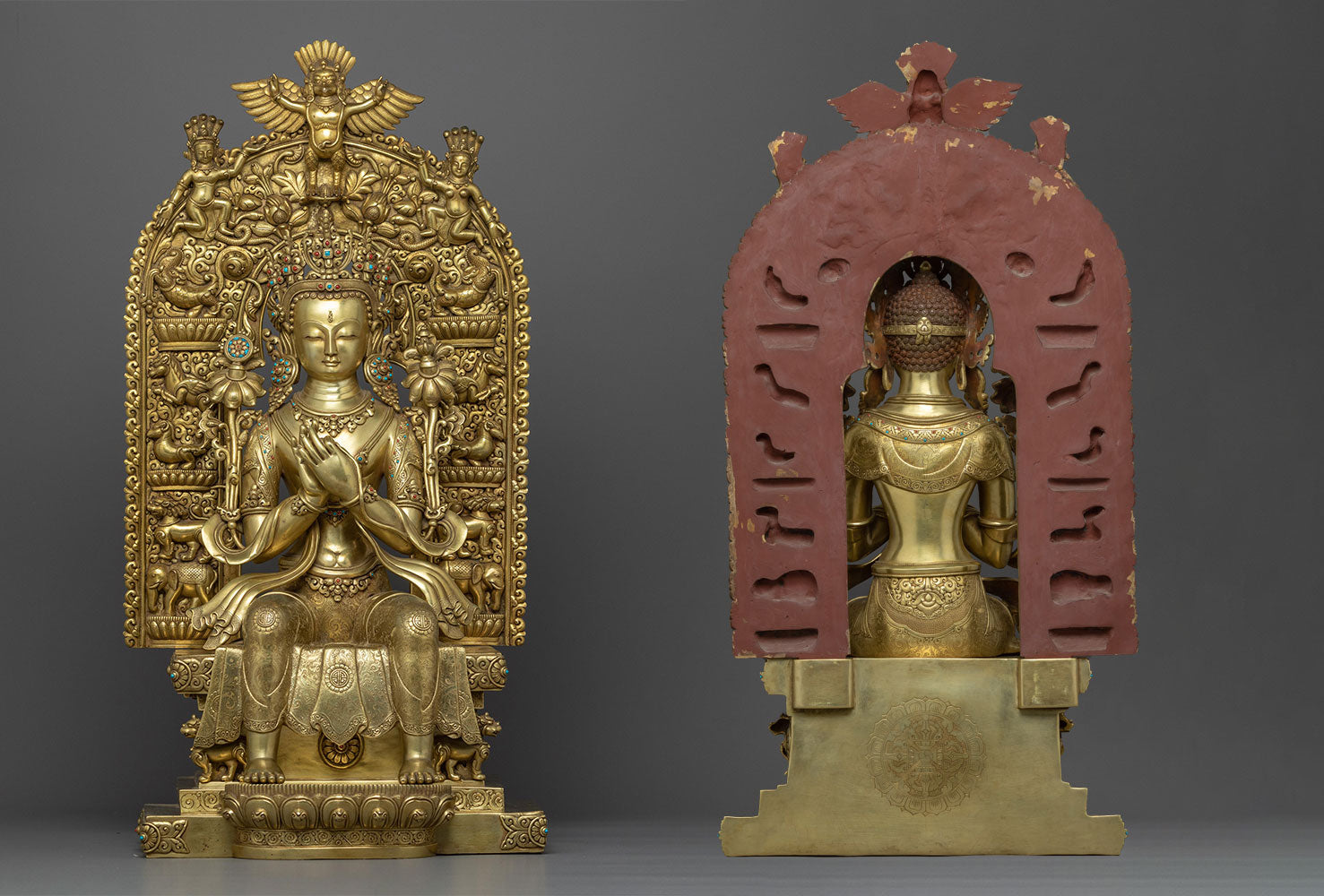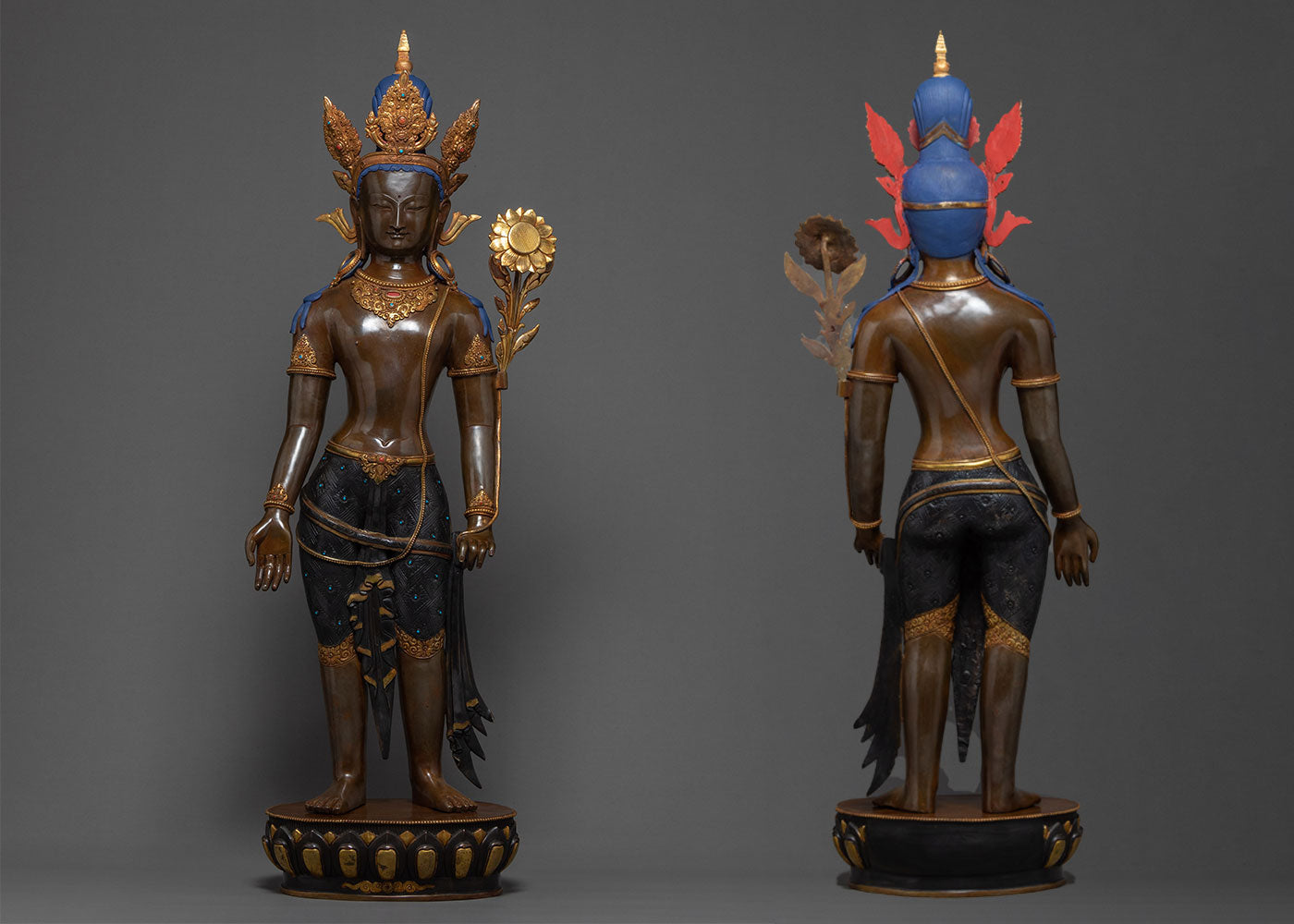The Profound Role of Buddhist Statues in Meditation
Meditation, an essential practice in Buddhism, is deeply intertwined with the symbolism and significance of Buddhist statues. The works of art embody Buddhist teachings and ideas beyond their status as mere artistic renderings. They operate as centers of attention for meditation, supporting those who practice them on their path to enlightenment, awareness, and tranquillity.
Key Takeaways
- Buddhist statues are integral to meditation practices, symbolizing various aspects of the Buddha's life and teachings.
- Meditation in the presence of these statues can enhance the spiritual experience.
- Different types of Buddhist statues represent other Buddhist concepts.
- The statues' material, posture, and gestures hold significant symbolic meanings.
The Significance of Buddhist Statues in Meditation
Click here to view our Buddha Statue Collection
-
Historical Context and Symbolism
Buddhist artifacts have existed for millennia and are more than just Buddha images. They are filled with rich symbolic implications, with each feature denoting a distinct teaching or period in the life of the Buddha. Using these sculptures in meditation areas gives the exercise a deeper, more spiritual dimension. -
Types of Statues and Their Meanings
The forms, stances, and expressions of the sculptures in Buddhist art are varied and extensive. Common conditions include Bodhisattvas, enlightened beings who postpone Nirvana to assist others, and Shakyamuni Buddha, who symbolizes the actual Buddha. Each kind has a distinct meaning that helps practitioners concentrate on various facets of Buddhist teachings.
More Than Just Symbols: Statues as Spiritual Guides
Buddhist statues are not mere symbols; they serve as spiritual guides in the meditation process. These statues, often depicting the Buddha or other enlightened beings, embody the qualities of enlightenment, such as compassion, wisdom, and serenity.
By meditating in the presence of these statues, practitioners are constantly reminded of these qualities, inspiring them to cultivate the same within themselves.
-
Visualization and Focus
Visualization is crucial to meditation, particularly in Buddhist practices like Vajrayana. Practitioners often use the image of a Buddha or a Bodhisattva as a focal point for this practice.
By gazing upon a statue, one can better visualize the qualities it represents, leading to a deeper and more focused meditative state. This process helps calm the mind and reduce distractions, making meditation more effective.
Exploring Meditation in Buddhism
Understanding Meditation in Buddhist Practice
In Buddhism, the goal of meditation is to cultivate awareness, focus, insight, and calmness. It is a tool for comprehending the mind, conquering pain, and reaching Nirvana.
These sculptures act as focal points in meditation, promoting attention and focus. The sculptures' placid looks and poses create a soothing atmosphere for in-depth reflection.
Techniques and Practices
Buddhist meditation involves various methods, such as concentration, loving-kindness, and mindfulness meditation. While every technique has its objectives and strategies, they all attempt to achieve higher awareness and tranquility.
The Interplay between Statues and Meditation
-
Enhancing Meditation with Statues
The presence of Buddhist statues during meditation can significantly enhance the meditative experience. They act as visual aids, helping to focus the mind and evoke feelings of peace, compassion, and wisdom.
-
Symbolism in Postures and Gestures
The postures and gestures of Buddhist statues, known as mudras, hold significant meanings. For example, the Dhyana Mudra represents meditation and concentration, while the Abhaya Mudra symbolizes protection and fearlessness. Understanding these symbols can deepen one's meditation practice. -
Enhanced Sense of Peace and Calm
The serene expressions commonly found on Buddhist statues profoundly affect the ambiance of a meditation space. These expressions evoke a sense of calm and peace, aiding practitioners in achieving a tranquil state of mind, which is essential for deep meditation. -
Improved Concentration
Meditating in the presence of a Buddhist statue can significantly improve concentration. The physical company of the figure serves as a gentle reminder to bring back the wandering mind to the present moment and the object of meditation, thus enhancing focus. -
Deepening Understanding of Buddhist Teachings
Statues often depict scenes from the Buddha's life or symbolize different philosophical concepts. Meditating in front of these statues can inspire practitioners to contemplate these teachings, deepening their understanding and appreciation of Buddhist principles.
Materials and Craftsmanship of Buddhist Statues
-
Variety of Materials Used
Buddhist statues are crafted from a range of materials, including bronze, stone, wood, and clay. Every component has a unique symbolic value and affects the energy and beauty of the monument.
-
Artistry and Craftsmanship
The skill with which these sculptures are crafted is, in and of themselves, a meditation. With their exquisite craftsmanship, skilled artisans endow each statue with a feeling of divinity, encapsulating the core teachings of the Buddha.
Impact of Buddhist Statues on Personal Meditation Practice
-
Personal Connection and Inspiration
A Buddhist statue in a practitioner's meditation area helps them feel more personally connected to the teachings. It reminds us of the journey to enlightenment and is a motivation source.
-
Cultural and Spiritual Significance
The statue also symbolizes Buddhism's rich cultural and spiritual legacy and its worldwide message of compassion and harmony.
Buddhist statues are essential for improving meditation techniques. They serve as both visual aids and metaphors for the profound lessons of Buddhism. A more concentrated, deep, and illuminating experience might result from including these sculptures in meditation routines.
| Feature | Description |
| Symbolism | Each aspect of the statues symbolizes different teachings and stages of the Buddha's life |
| Types of Statues | Shakyamuni Buddha, Bodhisattvas, Dakinis,etc |
| Materials | Bronze, stone, wood, clay |
| Mudras | Symbolic gestures with specific meanings |
| Meditation Techniques | Mindfulness, loving-kindness, concentration |
How Statues Aid Practitioners in Meditation
-
Serving as a Physical Representation of Inner Qualities
For many, a Buddhist statue is a physical representation of the qualities they are trying to cultivate through meditation – like compassion (Avalokiteshvara), wisdom (Manjushri), or fearlessness (Tara). This tangible representation can make these abstract qualities feel more accessible and accurate. -
Creating a Sacred Space
The presence of a Buddhist statue can transform an ordinary space into a sacred one conducive to spiritual practice. This sacredness helps set the right mood and intention for meditation, enhancing the overall experience. -
Aiding in Visualization Techniques
In certain meditation practices, such as Tibetan deity meditation, practitioners visualize themselves as the deity represented by the statue. This advanced practice is believed to help in the dissolution of the ego and the cultivation of the qualities represented by the Creator. -
Facilitating a Connection with the Lineage
Buddhist statues often symbolize the lineage and teachings of a particular school of Buddhism. Meditating in their presence can create a sense of connection to a larger community and tradition, providing support and belonging.
Incorporating the symbolic power of Buddhist statues into meditation practices offers a profound way to connect with the teachings of Buddhism and enhance the journey toward mindfulness and enlightenment.
Whether it's through enhancing concentration, helping in visualization, or creating a sacred space, these statues significantly contribute to the effectiveness and depth of meditation practice. Incorporating these statues into meditation routines can thus be a profoundly transformative experience, helping practitioners advance on their path to enlightenment.





1 comment
Antique Buddhas
Thank you so much for this insightful article on meditation statues! It beautifully explains the significance of these statues in deepening mindfulness and enhancing spiritual practices. The detailed descriptions of postures and symbolism really resonate, providing a deeper understanding of their role in meditation. I appreciate the effort put into sharing this knowledge!
Regards,
Antique Buddhas
https://www.antique-buddhas.com